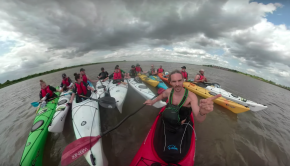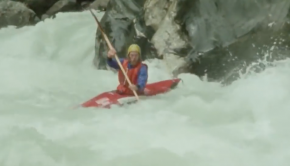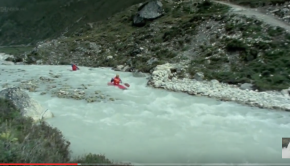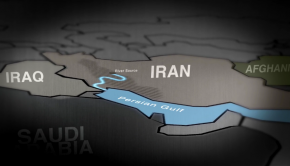Published on février 26th, 2018 | by Matt Dumoulin
Ultimate Descent: Paragliding off Everest and Kayaking to the Sea
Pretty crazy expedition… Would that be the ultimate descent for you?
« For most people, climbing Mount Everest is the ultimate life adventure and reaching the summit would be the journey’s goal, but for two unexpected friends, Sanobabu Sunuwar and Lakpa Tshiri Sherpa, it was only the beginning of their epic voyage together.
In a never before attempted feat, the two Nepali men set their sights on paragliding from Everest’s summit and then taking a near 500-mile kayaking trip on the Ganges River to the Indian Ocean in 2011. It was an excursion that would take months.
Only four people have ever glided off the top of Everest, and the story of Sunuwar and Sherpa is just as remarkable as their journey.
The two men tackled some of the most dangerous terrain and powerful rivers in the world without sponsors and without permits. Their story won the 2012 National Geographic Adventurers of the Year award.
On average, an Everest climb could cost a traveler usually tens of thousands of dollars to cover mountain permits and the brigade of sherpas — porters, cooks and guides — needed to get to the top.
Despite not having any high-altitude climbing experience nor deep pockets, Sunuwar was committed to climbing and then paragliding off Everest, without any permits if he had to.
Kimberly Phinney, an experienced climber and paragliding pilot in California, was one of the mission’s few early believers and remembered Sunuwar’s enthusiasm for the voyage. She said he told her, « We’re going to Everest, we have no sponsors, we have no equipment, but we’re going. »
With luck, Sunuwar met the perfect accomplice for this plan, Lakpa Tshiri Sherpa. Sherpa, a veteran mountaineer, decided to join his epic journey. While Sherpa was well trained for climbing Everest, he had never kayaked before and did not know how to swim.
Phinney recalled that, « the agreement was Lakpa would take Babu up Everest, and Babu would take Lakpa to the ocean. Lakpa knew everybody on Everest, all of the sherpas. They were able to kind of go in and utilize the cook’s camps. »
The duo slapped a basic plan together, and began their ascent of Everest, while borrowing food, supplies and cramped shelter from other expeditions.
Five days into their ascent, with dwindling supplies, Sunuwar and Sherpa began the climb into Everest’s death zone — above 26,000 feet. As they approached the summit, the men were in short supply of oxygen. At that point, turning back was not an option. The only way home was the paraglider.
The turmoil of climbing Everest dissipated once the men launched their paraglider. In just 42 minutes, the two pilots glided 15 miles to an airstrip in Namche, Nepal, which would have been an almost a two-week hike away by foot. However, their celebrations were brief.
Once they touched down, Phinney said the men heard that the army was after them for their renegade adventure and they were only half-way through their expedition.
Their soaring flight was not exactly legal, but easy compared to what lay ahead. Sunuwar and Sherpa had to cross Sun Kosi River’s grade five rapids, which Sunuwar called « dead man area. » When their boat capsized, a life jacket let Sherpa float down the river to safety.
They survived, but their trials continued. After the currents of the Himalayan River reached the Ganges River, the men were robbed.
From then on, Sunuwa and Sherpa hid in the reeds. Thanks to a nearby town with a Western Union, Phinney was able to transfer emergency funds to the men quickly. Once replenished, they continued on, surviving on fruit from trees.
Two months after jumping from the peak of Mount Everest, Sunuwar and Sherpa finally ran out of land to explore, and became the first people ever to complete the descent from Everest’s summit to the Indian Ocean.
« None of them had ever been to the ocean before, so this was kind of a whole new experience for them, » Phinney said. « I never doubted them, not for one single minute. »
As for their trouble with the law, Phinney said the men did face repercussions from the Nepali government for climbing Everest without permits, but « as much as the army was after them, all of the army guys were just like ‘That’s awesome,' » she said.
Although Everest has lured generations of international climbers, Sunuwar and Sherpa wanted to capture some glory for their native Nepal. For them, the adventure was a dream realized — an ultimate descent. »




